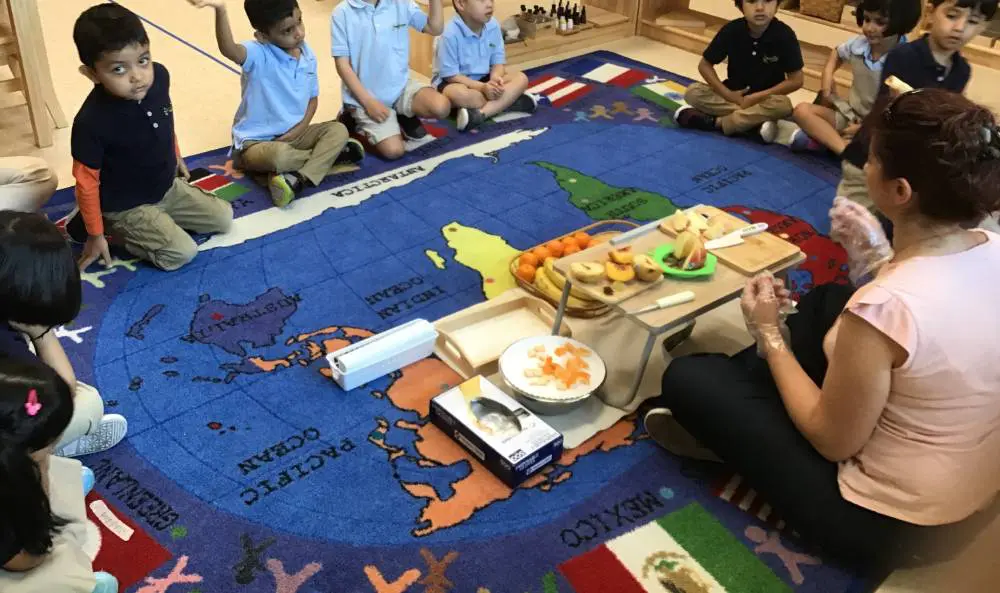A Brief Introduction About The Montessori Method
Curriculum at TFM
Our classrooms are divided into key areas of Montessori learning: Practical Life, Sensorial, Language, Math, and areas for art, music, geography, science, and cultural subjects. The Montessori Method is an integrated approach that ties the separate disciplines together. Enroll with us and get the Montessori difference.
Instruction is done in groups and individually and adapts to a child's learning style and developmental level.
A carefully prepared environment and method encourage the development of internal self-discipline. A child is an active participant in learning, allowed to move about and respectfully explore the classroom environment.
Teachers have knowledge of "sensitive periods" in a child's development when they are primed and ready to learn certain skills. Understanding this period, following the child's development, and offering appropriate lessons are part of the intense training of a certified Montessori teacher, also known as a Directress.
Each lesson is carefully designed to isolate one concept or skill so that a child is naturally drawn to become absorbed in the lesson and develop concentration and self-motivation. All materials have a "control of error" and are self-correcting so a child can check his work and continue to practice until he masters the task on hand. The materials are typically hand-crafted, of superior quality, and three-dimensional.


Normalization, Grace, and Courtesy
The first few weeks in a typical Montessori environment are important, as the ground rules and lessons in Grace and Courtesy are introduced. The process of normalization of a child into the ordered, calm environment of a classroom brings about periods of spontaneous concentration. This is the first step of education. In a normalized environment, children work with joy, know that each item has its place, love to maintain order in the classroom, and take pride in their work.
This is the time also when a child understands citizenship and community. They learn to respect each other's space.
Conflicts are resolved using a peace corner. Children are encouraged to be mentors, collaborate, and help each other.
Visitors to the School often comment about how quiet the classrooms are.
Practical Life
This area of the curriculum is designed to invite the child to practice real-life tasks such as spooning, tonging, sweeping, etc. These simple day-to-day activities foster independence, coordination, order, and concentration. It is a hallmark of the Montessori curriculum and often is the first lesson taught. This is the area where the child may first choose independent work. The practical life area is designed with carefully selected, life-like objects familiar to the child.
The lessons teach caring for the environment and the self to encourage responsibility and autonomy and promote high self-esteem. The ground rules set up for classroom discipline.
Sensorial
In Montessori philosophy, the senses are the "keys to the universe." Dr. Montessori believed that by learning to order, compare and classify sensory materials, children grow intellectually, and their development and future learning would be more meaningful and useful. These sensorial exercises fascinate children. The materials allow children to develop the mind and body connection. Important concepts introduced here prepare them for future learning in math, language, and science.
Language
In a Montessori classroom, many activities in all areas foster language and vocabulary development, communication skills, writing, and reading readiness.
In this area, the material is designed for phonetic learning, starting with beginning sounds.
In the Montessori Method, writing precedes reading, as the children explore by drawing and forming letters. Reading is prepared indirectly by writing using the letters and the sounds. Montessori students develop reading skills far superior for their age. Writing is encouraged when the child is ready and shows interest in beginning to write. As soon as this happens, children begin to record their own work and take pride in doing this routinely.
Mathematics
This subject is taught with concrete materials and not by memorization. Students who learn math by a rote method often do not have a real understanding. Montessori students use hands-on learning materials that make abstract concepts clear and concrete. By the age of 6 years, most of our students are able to perform addition, subtraction, multiplication, and division. They understand the concept of order and higher numbers, and a love of mathematics emerges. It is sheer joy to observe a child focused on completing the 45-layout, working with decimals, or skip counting with bead chains.
Cultural Subjects
Children naturally have a curious mind and often ask, "why does this happen?". Our role as educators is to facilitate them to gain an understanding of the beautiful world around them.
The Cultural Subjects curriculum includes a sound introduction to botany, zoology, chemistry, physics, geography, geology, and astronomy.
As the student begins to master skills, they will be introduced to specially designed maps and begin to learn the names of the world's continents and countries. Later the students begin to see the world's cultures in greater depth. They will learn to treasure the richness of their own cultural heritage and those of their friends.
Music and movement education are also important parts of the curriculum, as well as the Arts. The study of one Artist each month introduces them to many artists such as Picasso, Rembrandt, and many more.
Enrichment programs
Yoga and Stretch, General Music, Introductory Spanish, and Nature studies are included in our Curriculum at NO extra charge. To allow parents to enjoy the evenings with family at home, we offer extra-curricular programs such as Soccer Shots, Robotics, Dance, Spanish, Mandarin, and much more are offered for additional fees.
Awards





